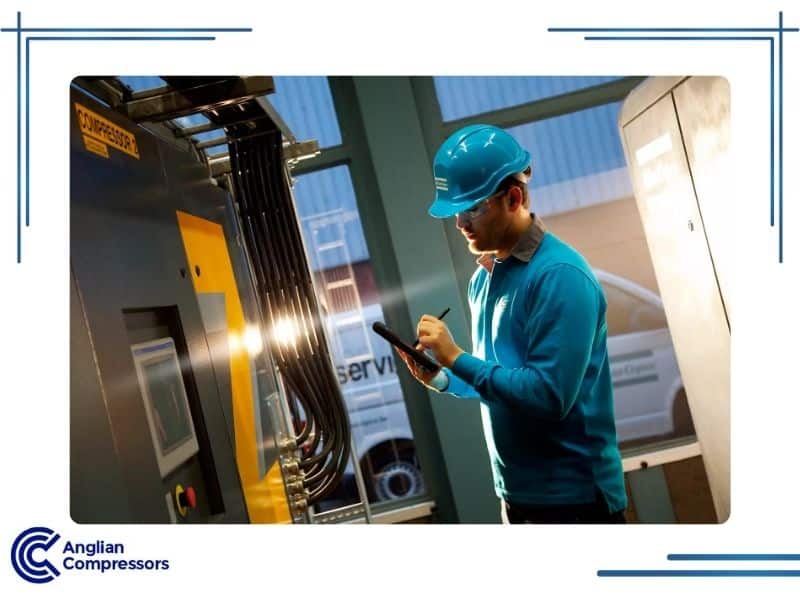What is Pressure Dew Point? A Practical Guide for UK Industry
Your compressed air system is a utility. It’s like electricity and water, but it’s different in one crucial respect: the quality of the compressed air service you receive isn’t guaranteed.
The ambient air entering your compressor contains water vapour. In a 55 kW compressor, for example, over 280 litres of water will be introduced into your pipework every day. The result is rust, equipment failure, and product contamination, and the Pressure Dew Point (PDP) is the number you need to control it all.
This guide breaks down what PDP is, why it matters to your operations, and how you can control it effectively.
Understanding Pressure Dew Point in Compressed Air Systems
You’ve likely heard the term “dew point” when watching a weather forecast. That dew point (DP) is the atmospheric dew point (ADP), when moisture in the air becomes dew. But using that DP to measure moisture in your compressed air system is asking for disaster.
Pressure Dew Point (PDP) is the temperature where water turns to liquid inside your compressed air system at its current operating pressure.
Why the difference? Compressing air forces water vapour into a much smaller space, making it far more likely to condense. Here’s why that matters to you: at 7 bar, a PDP of +3°C looks safe, but at atmospheric pressure, that’s like running at -23°C. Without knowing this, you could easily assume your air is dry when it’s actually saturated with water, ready to cause damage.

The High Cost of Uncontrolled Moisture
If your PDP is too high, it’s not a minor issue; it’s a direct threat to your equipment, your products, and your bottom line.
The Impact of Moisture on Your Operations
- Equipment Failure: Moisture causes rust and scale in your pipework. It also washes away lubricants from pneumatic tools and controls, causing them to wear out faster and fail unexpectedly.
- Product Contamination: If compressed air touches your product, any moisture becomes a contaminant, which can lead to:
- (Food & Beverage) The promotion of bacterial growth, risking product recalls, and non-compliance with BRCGS standards. You need dry air to avoid microbial contamination.
- (Automotive Painting) ‘Fish eyes’ and blisters forming, and a loss of adhesion necessitating expensive reworking.
- (Pharmaceuticals) A failure to maintain sterility, meaning non-compliance with tight MHRA & GMP regulations.
- Operational Downtime: Moisture laden air and pipes outdoors can freeze in cold UK weather, creating blockages that can bring your whole operation to a standstill.
How to Control Pressure Dew Point with Air Dryer Technologies
The only way to effectively control your PDP is with a dedicated air dryer. As an Atlas Copco Premier Distributor, Anglian Compressors supplies a full range of advanced air dryer technologies to achieve your target PDP.
Refrigerated Air Dryers
These dryers cool the compressed air down to +3°C, which forces the majority of water vapour to condense, allowing it to be drained away. Refrigerated air dryers are reliable and low-cost for general industrial applications with indoor pipework.
- Atlas Copco’s FD Series delivers a stable +3°C PDP and includes energy-saving modes to reduce your operating costs.
Desiccant Air Dryers
For critical applications, or systems exposed to freezing temperatures, desiccant dryers are essential. They use an adsorbent material to strip moisture from the air, achieving extremely low dew points.
- The Atlas Copco CD Series features Cerades™ solid desiccant, an innovation that prevents dust carry-over, extends service life, and lowers energy use.
- The BD+ Series is TÜV-certified for an ultra-low PDP below –90°C, meeting the demands of even the sensitive pharma, electronics, and food sectors.
You can learn more about how to choose between these options in our guide to the different types of air dryers.

ISO 8573-1 Compliance and UK PDP Standards
Achieving an appropriate PDP is not only good practice, but a strict requirement for passing ISO 8573-1 certification and UK regulation.
💡 Pro Tip: When designing any outdoor pipework, it is prudent to set your PDP no less than 10°C lower than the lowest ambient temperature it could be exposed to in the UK. This ensures you will not suffer from frozen pipework in the winter months.
UK manufacturers must reach certain levels of PDP when using compressed air in the food, pharmaceutical and healthcare industries in order to adhere to UK specific regulations, including BRCGS, MHRA/EU GMP Annex 1, HTM 02-01, and the international standard, ISO 8573-1. Failure to reach the required PDP level is a sure-fire way to have your facility face the risk of non-compliance fines and the financial implications of production recalls.
ISO 8573-1 is an international standard that defines air purity in relation to Particles, Water and Oil. For water there are 4 classes:
- Class 4: ≤ +3°C PDP
- Class 3: ≤ -20°C PDP
- Class 2: ≤ -40°C PDP (Typical for Food & Pharma)
- Class 1: ≤ -70°C PDP (For critical applications)
Additionally, all condensate removed from your system must be handled according to the Water Resources Act 1991, which requires proper condensate management.
Measurement, Monitoring, and Troubleshooting
If you don’t measure it, you can’t control it. It’s crucial that you know your dew point is where it should be to make sure your system is functioning correctly.
Verification and Monitoring
Continuous measurements are often provided by sensors, however, these can drift. Annual calibration is essential in order to have confidence in your readings. Anglian Compressors, a branch of Atlas Copco, provide ISO 8573-1 testing to verify that your PDP is compliant or that your measurements are accurate.
Online systems, such as Atlas Copco’s SMARTLINK, mean that you have real time visibility of your PDP and receive predictive maintenance alerts, so that you remain compliant and failures do not come as a surprise.
Troubleshooting a High PDP
If your PDP is high, don’t assume the dryer is broken. So, before calling for service, check for these common system-level issues:
- High Inlet Temperature: Is the compressor’s aftercooler clean and working?
- High Ambient Temperature: Is the compressor room properly ventilated?
- Blocked Drains: Are all condensate drains on receivers and filters clear? A single blockage can overwhelm your dryer.
Take Control of Your Compressed Air Quality
Want to avoid costly downtime and compliance risks? Speak with an Anglian Compressors specialist, from a branch of Atlas Copco, for a free PDP consultation. Our engineers provide ISO 8573-1 testing, full air audits, and tailored solutions to help you achieve the exact pressure dew point your processes require.


